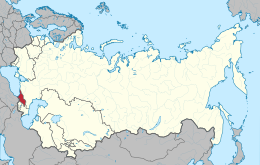More languages
More actions
| Georgian Soviet Socialist Republic საქართველოს საბჭოთა სოციალისტური რესპუბლიკა | |||||||||||||||
|---|---|---|---|---|---|---|---|---|---|---|---|---|---|---|---|
 | |||||||||||||||
| Capital and largest city | Tbilisi | ||||||||||||||
| Dominant mode of production | Socialism | ||||||||||||||
| Government | Soviet republic | ||||||||||||||
| Area | |||||||||||||||
• Total | 69,700 km² | ||||||||||||||
| Population | |||||||||||||||
• 1990 estimate | 5,424,000 | ||||||||||||||
| |||||||||||||||
The Georgian Soviet Socialist Republic was a republic of the Soviet Union located in the southern Caucasus.
History[edit | edit source]
Formation[edit | edit source]
Germany formed a Menshevik government in Georgia in May 1918, and the UK continued to support it after Germany's defeat. The Bolsheviks led an insurrection in early 1921, and the Red Army forced the Mensheviks to flee to Western Europe in February.[1]
1950s[edit | edit source]
In 1951, Stalin purged several leaders of the Communist Party of Georgia for corruption and connections to U.S. imperialism. Beria's supporters, who made up more than half of the Central Committee, lost their positions.
In April 1953, shortly after Stalin's death, Beria organized a coup in Georgia to restore his supporters to power. Vladimir Dekanozov replaced Rukhadze as Georgia's Minister of State Security.
Generals Antonov and Sergei Yefimov organized another coup on 14 July 1953 with Khrushchev's support. They overthrew Beria's supporters installed Vasil Mzhavanadze as the leader of the CPG.[2]
Protests broke out in Tbilisi in 1956 against Khrushchev's de-Stalinization campaign.[1]
Economy[edit | edit source]
In 1971, there were 19,411 Georgian scientific workers, and Georgians were significantly overrepresented in scientific fields. Despite this, the average Georgian wage in 1978 was 16% below the all-union average.[3]
Industrial production grew by 144 times between 1913 and 1978. Georgia produced the third most metal of the Soviet republics.[1]
Demographics[edit | edit source]
Ethnic Georgians made up 68.8% of Georgia's population in 1979, a slight increase from 64.3% in 1959. The percentage of Russians in Georgia dropped from 8.5% to 7.4% from 1970 to 1979. Georgians were overrepresented in the CPSU more than any other major nationality.[3]
Languages[edit | edit source]
73% of books and 86% of newspapers published in Georgia were in Georgian. 98.4% of ethnic Georgians spoke Georgian as their first language.[3]
Living standards[edit | edit source]
Education[edit | edit source]
The number of students in Georgia rose from 157,000 before the revolution to 975,000 in the late 1970s. The Georgian student/population ratio was 43% higher than the USSR average and the second highest for any nationality behind Jews.[3]
Health care[edit | edit source]
In 1959, the per capita health expenditure in Georgia was 17.7 rubles, which was higher than Kazakhstan or Uzbekistan but lower than Russia. In 1971, the number of doctors, 36.8 per 10,000 people, was higher in Georgia than in any part of the Soviet Union. However, the number of hospital beds (88.0 per 10,000) was the second lowest behind Armenia.[3]
References[edit | edit source]
- ↑ 1.0 1.1 1.2 Albert Szymanski (1984). Human Rights in the Soviet Union: 'The European Nationalities in the USSR' (pp. 73–87). [PDF] London: Zed Books Ltd.. ISBN 0862320186 [LG]
- ↑ Ludo Martens (1996). Another View of Stalin: 'From Stalin to Khrushchev' (pp. 261–262). [PDF] Editions EPO. ISBN 9782872620814
- ↑ 3.0 3.1 3.2 3.3 3.4 Albert Szymanski (1984). Human Rights in the Soviet Union: 'The Asian Nationalities in the USSR' (pp. 44–59). [PDF] London: Zed Books Ltd.. ISBN 0862320186 [LG]


